Introduction
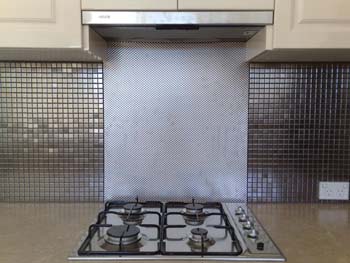
Stainless steel is a generic term for a family of corrosion resistant alloy steels containing 10.5% or more chromium. The chromium forms an invisible layer over the steel which keeps it lustrous and resistant to corrosion. The surface also has the ability to regenerate itself; so thankfully, mild scratches from abrasion will disappear in time. It is easily formed and welded, and so can be finished in a variety of interesting ways. Due to its sanitary qualities, stainless steel has been widely used in commercial situations. Its popularity in residential building is also due to its design merits- its unique luster and reflective qualities can both blend and contrast with other cabinetry and cladding materials.
Benefits of Stainless Steel
Stainless steel has some quite unique benefits. It is unaffected by temperature extremes, and is resistant to corrosion. It is strong and easily fabricated. Stainless steel has a long life, and is durable, easily cleaned and maintained. Its surface reflects and dissipates light (in different ways depending upon the surface finish) and brightens the environment in which it is used.
Types of Stainless Steel
There are five different types of stainless steel, each with different percentages of chromium, (and in some nickel.) Almost all stainless steel sheeting for domestic and commercial use is Austenitic steel . A typical composition of this most common type is 18% chromium, 10% nickel. It is most often used in flat sheeting. Austenitic and Ferritic grade (which is more corrosion resistant but less durable) are used in 95% of stainless steel applications.
Grades of Stainless Steel
There are about 150 grades of stainless steel, each with different percentages of metal additives, about 15 of which are most commonly used. Different grades have different hardness, malleability, anti corrosion, hardness, weight, heat resistance, formability, water resistance, salt resistance, rust resistance, luster, suitability for welding, metallic contamination, wear resistance, polishability and stain resistance. Of these, Grade 304 is the most versatile and most widely used stainless steel, available in a wide range of products, forms and finishes. Grade 316 (also known as marine grade stainless steel) is the second most common grade. It has a higher chromium content (up to 26%) and is used in harsh environments and where chlorides are prevalent, ie up to 5 kms from the coast. Grade 316 is also used in food preparation and surgery situations where minimal metallic contamination is required.
Stainless Steel Finishes
Stainless steel sheeting for both interior and exterior use is available in a wide variety of both subtle and striking finishes. Sheets can be brush, matte, reflective, mirror, satin, bead blasted or coarse abrasively finished. They are available in a variety of patterns and decorative effects and can even be custom patterned or etched. Different patterns will produce different diffusion results and this lighting effect can also be subtle or dramatic. (One of the most dramatic applications to date has been Tridente Architects' use of a coloured cellular design for the cladding their Sacred Heart School project. See picture.)
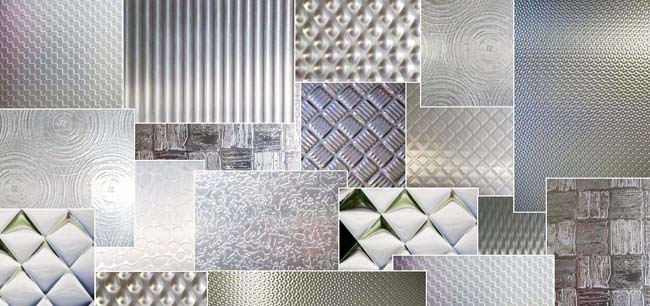
Some interesting stainless steel finishes
Applications of Stainless Steel in Residential Buildings
Stainless steel has been very successfully used in the following situations: cladding, facades, feature walls, and decorative walls. Stainless steel sheeting is readily purchased off the shelf , usually as 2438 x 1250 mm x .6 or 1.2 mm thickness. It can be easily cut to order and readily formed to shape. The cladding can also be supplied in convenient wall panels - stainless steel sheeting that is neatly wrapped around plasterboard which can be easily fixed to timber or steel frames. The panels come with a smartly conceived little edge fold that allows them to be spaced or fitted snug, depending upon the effect desired. Like plaster board, the panels can be fixed with glue. Cornices are not required.
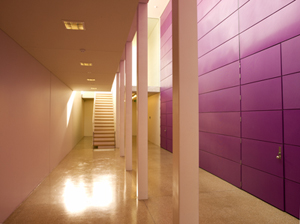
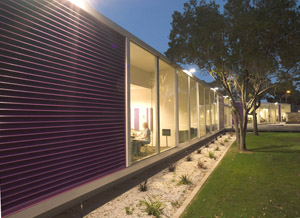
Stainless steel used on the exterior and interior of a building
Stainless steel can be finished in a large selection of colours. This is useful when a particular decor demands the use of complimentary colours or the natural colour of stainless steel is undesirable. Shown below are a selection of coloured and textured stainless steel splashbacks.

Some colourful and textured stainless steel finishes
Stainless steel in roofing materials
When stainless steel is used for guttering and down-pipes, the simple functionality of the piping is transformed to a design element, becoming an integral part of the architectural geometry of the house. The strong linear lines of the steel down pipes accentuates the rectangular shapes of the building (see picture). This works particularly well where the exterior walls are rendered and other stainless steel has been used, e.g. in balustrades.
Stainless steel balustrades and stair cases
Due to its durability and lustrous appearance, stainless steel is very popular for hand rails, balustrades and its wiring, for both external and internal use. It can also be used as stair stringers, treads and even more dramatically, as the structural support. Next page >>
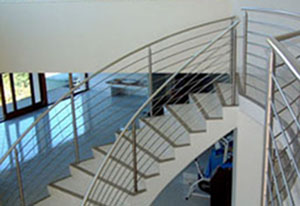 |
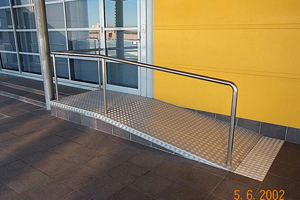 |
Examples of stainless steel being used in a balustrade and a wheelchair ramp
